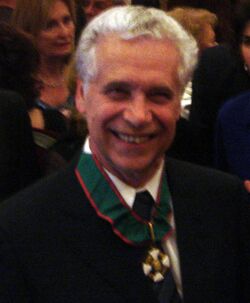Biography:Gabriele Veneziano
Gabriele Veneziano | |
|---|---|
 (2007) | |
| Born | 7 September 1942 Florence, Italy |
| Alma mater | University of Florence Weizmann Institute of Science |
| Known for | String theory Veneziano amplitude String cosmology |
| Scientific career | |
| Fields | Theoretical physics |
| Institutions | Collège de France |
Gabriele Veneziano (/ˌvɛnətsiˈænoʊ/;[citation needed] Italian: [venetˈtsjaːno]; born 7 September 1942)[1] is an Italian theoretical physicist and one of the pioneers of string theory.[2][3] He has conducted most of his scientific activities at CERN in Geneva, Switzerland, and held the Chair of Elementary Particles, Gravitation and Cosmology at the Collège de France in Paris from 2004 to 2013.[2]
Life
Gabriele Veneziano was born in Florence. In 1965, he earned his Laurea in Theoretical Physics from the University of Florence under the direction of Raoul Gatto. He pursued his doctoral studies at the Weizmann Institute of Science in Rehovot, Israel and obtained his PhD in 1967 under the supervision of Hector Rubinstein. During his stay in Israel and his early years at MIT, he collaborated with Marco Ademollo (a professor in Florence), Miguel Virasoro.[2] and Sergio Fubini.
Between 1968 and 1972 he worked at MIT and CERN. In 1972 he became Amos de Shalit Professor of Physics at the Weizmann Institute of Science and in 1976 he accepted a position in the Theory Division at CERN in Geneva, Switzerland where he worked for more than 30 years and directed the Theory Division (between 1994 and 1997). He currently holds the chair of Elementary Particles, Gravitation and Cosmology at the College of France in Paris, France. In fall 2012, he spent a semester at New York University as Global Distinguished Professor.
Research
Gabriele Veneziano first formulated the foundations of string theory in 1968 when he discovered a string picture could describe the interaction of strongly interacting particles.[4][5][6] Veneziano discovered that the Euler Beta function, interpreted as a scattering amplitude, has many of the features needed to explain the physical properties of strongly interacting particles. This amplitude, known as the Veneziano amplitude, is interpreted as the scattering amplitude for four open string tachyons. In retrospect this work is now considered the founding of string theory although at the time it was not apparent the string picture would lead to a new theory of quantum gravity.
Veneziano's work led to intense research to try to explain the strong force by a field theory of strings about one fermi in length. The rise of quantum chromodynamics, a rival explanation of the strong force, led to a temporary loss of interest in string theories until the 1980s when interest was revived.
In 1991, he published a paper[7] that shows how an inflationary cosmological model can be obtained from string theory, thus opening the door to a description of string cosmological pre-big bang scenarios.
Society memberships
- National Academy of Sciences of Turin (1994);
- Lincei National Academy (1996);
- French Academy of Sciences (2002).
Awards
- Pomeranchuk Prize, 1999
- Gold medal della Repubblica Italiana come Benemerito della Cultura, 2000
- Dannie Heineman Prize for Mathematical Physics, from the American Physical Society, 2004
- Enrico Fermi Prize from the Italian Physical Society, 2005
- Albert Einstein Medal, Albert Einstein Institute, Bern, Switzerland, 2006
- Oskar Klein Medal, 2007
- Commendatore al merito della Repubblica Italiana, 2007
- James Joyce Award, University College Dublin, 2009
- Felice Pietro Chisesi and Caterina Tomassoni Prize, 2009
- Dirac Medal by ICTP, 2014
- Honorary doctorate, Swansea University, 2015[8]
- Friedel-Volterra Prize, by SIF and SFP, 2016–2017
References
- ↑ Biography on the Collège de France website
- ↑ 2.0 2.1 2.2 "biography and bibliography". College de France. http://www.college-de-france.fr/default/EN/all/par_ele_en/index.htm.
- ↑ Gasperini, F.; Maharana, J. (2008). "Gabriele Veneziano: A Concise Scientific Biography and an Interview". in Gasperini, Maurizio; Maharana, Jnan. String Theory and Fundamental Interactions – Gabriele Veneziano and Theoretical Physics: Historical and Contemporary Perspectives. Lecture Notes in Physics. 737. Springer. pp. 3–27. doi:10.1007/978-3-540-74233-3_1. ISBN 978-3-540-74232-6. http://www.college-de-france.fr/media/par_ele_en/UPL30277_Veneziano.bio.pdf.[yes|permanent dead link|dead link}}]
- ↑ Veneziano, G. (1968). "Construction of a crossing-symmetric, Regge-behaved amplitude for linearly rising trajectories". Nuovo Cimento A 57 (1): 190–7. doi:10.1007/BF02824451. Bibcode: 1968NCimA..57..190V. http://cds.cern.ch/record/390478.
- ↑ Lovelace, C.; Squires, E. (1970). "Veneziano Theory". Proc. R. Soc. Lond. A 318 (1534): 321–353. doi:10.1098/rspa.1970.0148. Bibcode: 1970RSPSA.318..321L. http://cds.cern.ch/record/350802.
- ↑ Di Vecchia, P. (2008). "The Birth of String Theory". in Gasperini, Maurizio; Maharana, Jnan. String Theory and Fundamental Interactions – Gabriele Veneziano and Theoretical Physics: Historical and Contemporary Perspectives. Lecture Notes in Physics. 737. Springer. pp. 59–118. ISBN 978-3-540-74232-6. http://www-hep.physics.uiowa.edu/~vincent/courses/29276/Vecchia.pdf.
- ↑ Veneziano, G. (1991). "Scale factor duality for classical and quantum strings". Physics Letters B 265 (3–4): 287–294. doi:10.1016/0370-2693(91)90055-U. Bibcode: 1991PhLB..265..287V. http://cds.cern.ch/record/220581.
- ↑ "Professor Gabriele Veneziano". https://www.swansea.ac.uk/graduation/honoraryawards/honoraryawardsarchive/honoraryawards2015/professorgabrieleveneziano/.
External links

